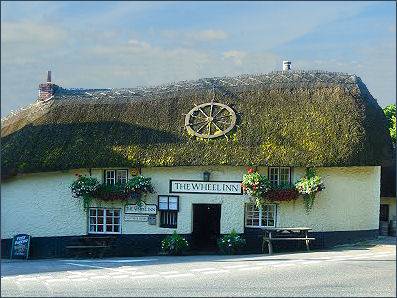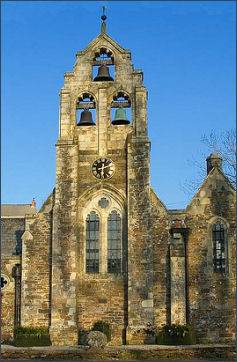Tresillian
OS Grid ref:-
 The pleasant and quiet riverside village of Tresillian is situated around three miles (5 km) to the east of the historic cathedral city of Truro, and stands on the A390 road.
The pleasant and quiet riverside village of Tresillian is situated around three miles (5 km) to the east of the historic cathedral city of Truro, and stands on the A390 road.
The name was thought to mean 'place of eels' in Cornish, however modern experts agree gree that it in fact translates as farm/settlement of a man called Sulyen.
Tresillian was the home of Robert Tresilian, Chief Justice of the King's Bench between 1381 and 1387. He was put in charge of punishing the rebels after the Peasant's Revolt, and did so extremely harshly. Tresilian was later among a number of those loyal to King Richard II who were charged with treason by the Lords Appellant. Having taken sanctuary at Westminster he was tried in absentia and dragged out of the church and hung.
 During the Civil War, a meeting took place at Tresillian in 1645, between the Parliamentary General Thomas Fairfax and the Royalist commander in Cornwall. Fairfax, commander of the New Model Army, dispatched a summons of surrender to the Ralph Hopton, 1st Baron Hopton, who had been given command of the Royalist forces in Cornwall by Charles, Prince of Wales. Hopton's army was in disarray but he had previously refused to surrender. However, news at Bodmin of an imminent Irish invasion further damaged the Royalist cause locally. Hopton responded on 8th March that he was willing to negotiate terms.
During the Civil War, a meeting took place at Tresillian in 1645, between the Parliamentary General Thomas Fairfax and the Royalist commander in Cornwall. Fairfax, commander of the New Model Army, dispatched a summons of surrender to the Ralph Hopton, 1st Baron Hopton, who had been given command of the Royalist forces in Cornwall by Charles, Prince of Wales. Hopton's army was in disarray but he had previously refused to surrender. However, news at Bodmin of an imminent Irish invasion further damaged the Royalist cause locally. Hopton responded on 8th March that he was willing to negotiate terms.
General Fairfax agreed to negotiate and on March 10, 1645 both sides met at Tresillian Bridge. Hopton agreed to move his army to St Allen, four miles (6.5 km) to the north of Truro, as a gesture of trust and goodwill allowing Fairfax to occupy Truro. Cannon balls and cannon have been found, although no battle was fought here. Charles, Prince of Wales fled to Falmouth from where he escaped to the Scilly Isles.
The Wheel Inn at Tresillian is Grade II Listed building and is said to be to have been used as Fairfax's headquarters during the Civil War. The inn, which displays a spoked wheel of straw on its thatched roof, dates back to the fourteenth century. The Wheel Inn serves locally brewed ales and good food at reasonable prices.
A new church, Holy Trinity (right), was constructed at Tresillian Bridge in 1904, which is famous for its flat tower. The font, bells, statue of St Anthony and pulpit from nearby Merther church were moved to the new church.
On the opposite bank of the Tresillian River is the Tregothnan estate, the home of Lord Falmouth. The estate is an official 'safe site' for the keeping of rare or endangered trees from all over the world. Although not open to the general public, visits to this amazing garden and arboretum made be made by prior appointment.